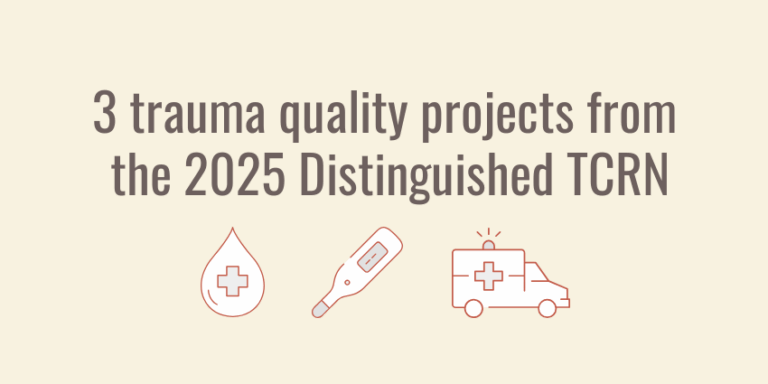The winner of the 2025 Distinguished TCRN Award is Kristi Bonny, BSN, RN, CPHQ, TCRN, EMT-P, trauma clinician at Texas Health Presbyterian Hospital Plano, a Level II trauma center in Plano, Texas.
This annual award is presented by the Board of Certification for Emergency Nursing (BCEN) to a Trauma Certified Registered Nurse who demonstrates exceptional commitment to clinical excellence and support for nursing specialty certification.
Bonny was nominated for this honor based on her professionalism, strong work ethic, compassion and her commitment to trauma performance improvement.
Recently, Bonny talked about three successful trauma PI initiatives that she led at Texas Health Plano.
1. Reducing time to blood product administration
“We were drilling down on some of our MTPs and we noticed that we were giving a lot of crystalloid, a median of up to 3 liters,” Bonny said. “And as we started digging deeper, we realized that our median time from patient arrival until the blood started was about 40 minutes.”

Bonny assembled a multidisciplinary group of trauma, ED and blood bank leaders to examine the problem. The team found that multiple time-consuming steps were built into the blood request process. For example, the trauma team waited for the patient to arrive before making any decision about blood.
The group also noted that extended wait times led directly to higher crystalloid utilization. “Basically, if a patient became hemodynamically unstable while the resuscitation team was waiting for blood products, they would hang crystalloids, trying to turn a non-responder into a responder,” she said.
Their solution — the Level One Blood Cooler. Under the new system, the Blood Bank automatically sends blood products for all full trauma team activations.
“We knew that our Level One patients are at highest risk for needing blood products, so as soon as the Blood Bank is notified of a level one activation they immediately begin preparing a cooler and an ED runner is assigned to go get it automatically,” Bonny said. “We initiated this for every single full activation, whether or not we think the patient will actually need it.”
The new process was introduced in 2021 and it led to immediate improvements:
- The median time from patient arrival to first transfusion decreased from about 40 minutes to approximately 9 minutes.
- And with faster availability of blood, median crystalloid administration dropped from about 3 liters to approximately 1 liter.
“It seemed like the overall hesitancy to start blood products had been removed,” she said. “Not that we were giving blood products that didn’t need to be given, but just not delaying them when it looked like we were going in that direction.”
Initially, the Level One Blood Cooler contained 2 units of RBCs and 2 units of plasma. When Texas Health Plano adopted whole blood, the process was easily adapted to the new resuscitation protocol.
2. Preventing hypothermia during trauma resuscitations
In 2022, Bonny was selected to take part in an evidence-based nursing practice fellowship at Texas Christian University. For her fellowship project, Bonny chose to focus on preventing hypothermia in trauma patients.
“Over a period of about three months, we realized that approximately 11% of our full activation trauma patients were arriving normothermic but becoming hypothermic during the course of our resuscitation,” she said.
According to Bonny, resuscitation teams mainly used pre-warmed cotton blankets to manage patient temperature. Occasionally, if a patient showed signs of coldness, a forced-air warming blanket would be used. “But nobody really liked that because it was like having a raft in the trauma bay that just floated above the patient,” she said.
While performing a literature review, Bonny found several studies demonstrating good results from under-the-body warming blankets.
“We thought, this is genius because we can provide continuous heat to the patient from underneath,” she said. “Those of us in the ED had never heard of it, but in fact they were using it in the OR at our hospital.”
Bonny presented the data to ED nursing staff and explained the proposed solution. The team then launched a three-month pilot study to test under-body warming during trauma resuscitation.
“During that three months, we had no incidences of patients developing hypothermia during their resuscitation,” she said.
While the new warming strategy showed immediate results, some troubleshooting was required.
“The blanket has a port at the head of the bed and one at the foot,” Bonny said. “Initially, because the head of the bed is typically pretty crazy with intubation and other things, we decided to connect the tubing at the foot — but then the power cord was running across the room.”
Nursing staff brainstormed solutions. They eventually found that a top-of-the-bed connection is manageable if the tubing is set up before the patient arrives and the power cord is run underneath the boom so it is not a trip hazard.
According to Bonny, one side benefit is that the project significantly improved patient temperature documentation. “It created a greater awareness of documenting temperatures because staff knew we needed that data to be able to see whether or not the new warming strategy was working for patients.”
3. Streamlining trauma response by enabling EMS activations
“Very soon after I started in this role, we received a specific piece of feedback from one of our EMS partners regarding a recent patient,” Bonny said. “Although the patient did not meet hospital-specific activation criteria, the EMS team felt the patient should have received a trauma activation.”
In response, trauma program leaders took a fresh look at activation processes. Given the long-standing and widely accepted practice of STEMI and stroke team activations by EMS providers, why not accept EMS provider judgement for trauma activations?
Starting in 2019, Texas Health Plano empowered all 13 EMS agencies in the hospital’s service area to call trauma activations from the field.
“It really just made sense,” she said. “After all, the EMS crew has assessed the patient, the scene and the mechanism of injury, so if they ask for a trauma activation we trust their judgement and clinical skills and we provide, at minimum, a partial activation. If their report meets our Level One criteria, we initiate a full activation.”
According to Bonny, the field activation policy has not led to overutilization of resources and has helped the trauma program hone its activation criteria.
“We’ve also received great feedback from EMS,” she said. “They like knowing that their judgment is heard by us and valued.”
Learn more at BCEN.org — Meet Kristi Bonny: BCEN’s 2025 Distinguished TCRN Award Winner

